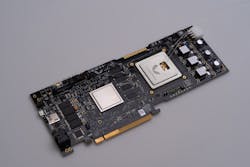This article is part of the TechXchange: Silicon Photonics.
What you’ll learn:
- Silicon photonics, which integrates optical and electrical components onto a single package, is used for high-speed interconnects in computing systems between processors, memory, and other resources.
- Silicon photonics can replace traditional digital circuits for computation and network-on-chip (NoC) fabrics.
- Silicon photonics offers a more compact and efficient solution for data transfer between components and improves the overall performance and power consumption of the system.
Silicon photonics is a technology that uses silicon-based materials to manipulate and transmit light to create lower-latency compute and interconnect solutions. One of the main advantages is its ability to integrate optical components onto a single package with electronic components. This allows for the creation of highly integrated systems that can process both electronic and optical signals, potentially leading to more efficient and compact devices.
Many misconceptions abound about how to use photonics to enhance today’s designs. Its potential is understood, but is it ready to be deployed? Overall, the value of silicon photonics lies in its potential to enable new technologies and applications that were previously not possible with traditional electronic circuitry, as well as to improve the efficiency and performance of existing technologies. So, what myths have emerged? We look at 11 of them, and present the evidence to debunk them.
1. Nice research project, not commercially viable today.
Silicon photonics has been gaining interest in recent years due to its potential to offer high-speed data transfer, increased bandwidth to memory, and low-power consumption. While some challenges are still associated with its implementation, silicon photonics has already shown promising commercial viability in various applications (Fig. 1).
One application is in data-center interconnects, where it can offer high bandwidth, low latency, low power consumption, and rack-to-rack connections. High-speed copper connections have length limitations without using repeaters. Silicon photonics can improve data-center interconnect by providing lower-latency Compute Express Link (CXL) connections between servers, GPUs, and memory pools.
The use of standard CMOS fabrication processes for silicon photonics may be able to reduce the cost and complexity of manufacturing, making it a more viable commercial solution.
2. CMOS will continue to scale according to Moore’s Law.
Since the start of the semiconductor industry, computing power improvement can be described by Moore's Law: Transistor density doubles every 18 months, enabling CMOS chips to continuously improve computing power while maintaining constant energy and area consumption.
As the chip manufacturing process moves to 5 nm and 3 nm, transistor density is close to its physical limit. Moore's Law is slowing down and the traditional single-chip computing power improvement path is unsustainable.
Silicon photonics is a technology that will allow scaling to continue beyond the limits of Moore’s Law. Digital chips are now limited by the physical limits of the underlying component––the CMOS transistor. Optical signals and devices follow different physical principles. The interactions of optical signals are typically linear and can be mapped as linear calculations. They should enable optical compute accelerators to outperform CPUs and GPUs over time.
3. Silicon-photonics use cases are very narrow.
Silicon photonics is a technology that uses silicon as a platform for the generation, manipulation, and detection of light. It’s a mature technology in telecom and data-center applications for transporting information over fiber connections.
It’s now applied to other compute needs, where high bandwidth and low latency are required for scaling systems and has the potential to revolutionize a wide range of industries.
Some applications include:
- Data-center interconnects to transmit large amounts of data over long distances at high speeds.
- High-performance computing to connect multiple processors together, enabling faster data transfer and reduction of I/O bandwidth to large memory pools.
- Telecommunications networks to increase capacity and speed of data transmission.
- LiDAR systems for self-driving cars and other autonomous vehicles, enabling precise and accurate distance measurements.
- Quantum computing to control and manipulate qubits, opening the door to faster and more efficient quantum computations.
4. Photonics requires a significant shift in methodology.
Leveraging silicon photonics requires extending the existing methodology from traditional electronics to photonics. In electronics, the information is transmitted and processed using electrons. In photonics, information is transmitted and processed using light. Fabricating photonic ICs will require a different set of design rules, fabrication processes, and testing methodologies.
Using photonic ICs in a system leverages existing methodologies and design rules. Many photonic ICs use electronic ICs in a co-packaged configuration to translate electrical signals to optical signals and back to electrical signals. The application is transparent to the system designer since the optical signals are internal to the device.
5. Implementing silicon photonics would require a steep learning curve for adoption.
The learning curve to fabricate silicon photonic devices is not as steep as other emerging technologies. Silicon photonics involves the integration of multiple disciplines, including electronics, optics, materials science, and fabrication techniques.
Adopting silicon-photonics ICs is similar to electronic ICs since the photonics ICs are generally co-packaged with electronic ICs. These ICs typically have electrical interfaces and behave similarly to other ICs in the design of a system.
6. Digital ICs and photonic ICs are hard to integrate.
Integrating digital and photonic ICs is possible, and it’s been proven by several companies producing photonics ICs using a hybrid approach to ensure their reliability and performance.
A hybrid integration approach is often employed to integrate electronic and photonic ICs by fabricating digital and photonic circuits separately and then bonding them together. This can be done using various techniques, such as flip-chip bonding, wire bonding, or solder bonding.
The design and fabrication of hybrid ICs requires careful consideration of several factors, including thermal management, electrical and optical coupling, and packaging. Because digital circuits can generate a significant amount of heat that can affect the performance of photonic circuits, thermal management is critical to ensure the reliability and stability of the ICs.
7. Artificial-intelligence/machine-learning (AI/ML) workloads will continue to scale on GPUs.
AI/ML workloads scale on GPUs without the use of photonics and are the workhorse of AI/ML training due to their ability to handle parallel-processing tasks, critical for training large models. Thanks to recent improvements in GPU performance, they can handle increasingly complex AI/ML workloads.
However, as AI/ML workloads continue to grow in complexity and size, faster and more efficient data transfer is needed between GPUs and other processing units. This is where photonics can play a role by enabling high-speed, low-latency interconnects between GPUs, CPUs, and other processing units to boost efficiency and data-transfer speed.
As AI/ML models become more complex, specialized hardware accelerators, such as tensor processing units (TPUs) and field-programmable gate arrays (FPGAs), will be required. These accelerators can use silicon photonics for efficient interconnects and data transfer via low-latency CXL connections.
In addition, new photonic accelerators use low-latency optical NoCs (optical network on chip or oNoC) to increase performance and throughput of AI workloads. For specific functions, these accelerators are up to 800X faster than the most advanced GPUs.
8. Digital chips at 3 nm have better performance.
It’s difficult to directly compare the performance of digital chips at 3 nm and silicon-photonics chips because they’re designed for different applications and use different metrics to measure performance. The choice depends on the specific application requirements and design considerations.
Digital chips at 3 nm are designed to process digital information, such as performing arithmetic operations, logic functions, and memory operations. They’re optimized for high-speed computation and low-power consumption, which is critical for applications such as mobile devices, data centers, and high-performance computing.
Silicon-photonics chips are designed primarily for transmitting and processing optical signals. They’re optimized for high-speed data transfer and low-power consumption, critical for applications such as data communication, sensing, and medical imaging.
While digital chips at 3 nm may have better performance than silicon-photonics chips for digital processing tasks, silicon-photonics chips have the potential to offer higher bandwidth and lower latency for data transfer over longer distances. For example, photonics can be used to improve a digital chip’s access to memory and significantly reduce the memory I/O bottleneck. In addition, silicon-photonics chips can offer higher energy efficiency for certain applications in which reducing power consumption is critical.
9. Optical NoCs are too small to be practical.
Optical NoCs have the potential to offer high-bandwidth and low-latency communication between on-chip processing units. The practicality depends on various factors, such as cost, power consumption, reliability, and scalability.
The cost of implementing an optical NoC requires specialized components—e.g., lasers, modulators, and detectors—that can be expensive to manufacture and integrate. While optical communication may offer low-power consumption compared to electrical communication, the power consumption of optical components, such as lasers and modulators, still often runs high.
Optical NoCs hold several key advantages over their digital counterparts. Since connections between the digital chips use light, oNoCs are extremely low latency and can communicate with all nodes across the device at the same time. This solves the nearest-neighbor problem with digital ICs and enables new topologies to be considered.
Unlike digital NoCs, oNoCs aren’t limited to a single reticle. With wafer stitching, oNoCs can provide wafer-scale density when using standards like the Universal Chiplet Interconnect Express (UCIe) for the digital interfaces between chiplets.
10. CXL is fine with copper interconnect, not optical interconnects.
CXL is a high-speed interconnect standard designed to enable communication between CPUs, GPUs, memory, and other processing units. While the initial versions of CXL use electrical interconnects, utilizing optical interconnects for CXL beyond a meter is growing in interest.
Optical interconnects can offer higher bandwidth, lower latency, and lower power consumption compared to electrical interconnects, especially over longer distances. Using optical interconnects for CXL beyond a meter can also enable more flexible system design and deployment. With optical interconnects, processing units may be placed further apart, allowing for more flexible system configurations and reducing the need for complex cabling.
11. Other technologies are more promising.
Silicon photonics is being used for high-speed interconnects in computing systems, including interconnects between processors, memory, and other components. Another application is in the development of co-packaged photonic ICs with electronic ICs. These packages offer a more compact and efficient solution for data transfer between components in computing systems, reducing the need for complex cabling and improving the overall performance and power consumption of the system.
This article is part of the TechXchange: Silicon Photonics.

